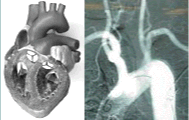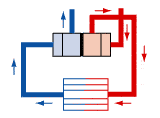Our blood circulation system is simple in principle, yet important and complex in detail. It makes for a great example of a hydraulic system. Learn about the flow and the storage of fluids by working on activities that lead to a model of blood flow through the systemic circuit.
The systemic circuit is that part of the blood flow system that goes from the left ventricle (left chamber) of the heart through the aorta into the major parts of the body (there also is the pulmonary circuit through the lungs where the blood picks up oxygen).
Blood delivers oxygen and nutrients to the cells of the body. It picks up waste products and is collected and flows back to the heart through the veins.
How does the circulatory system—viewed from a hydraulic perspective—work? What physical processes make this system tick? Answering these questions may help us decide what we have to study to be able to solve the problem in the end.
| |
Blood Pressure and Flow Data
For more information see |

